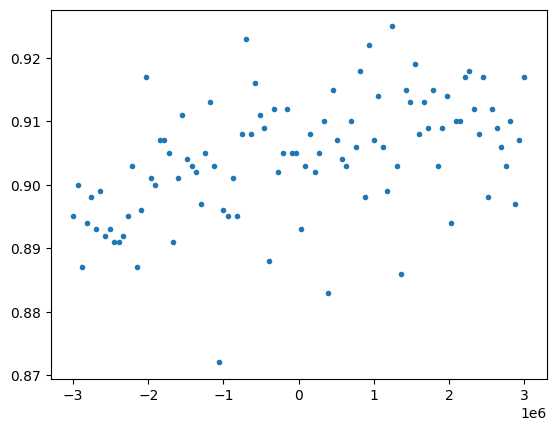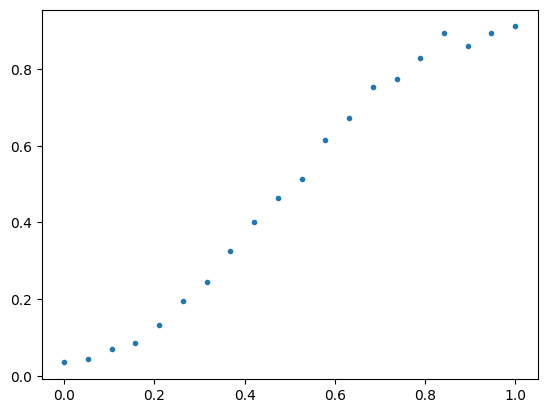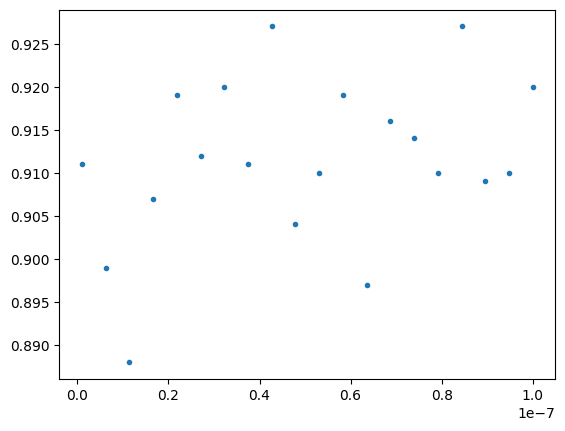Parametric compilation examples¶
In this notebook, we demonstrate parametric compilation by way of three “experiments”:
Qubit Spectroscopy, in which we sweep over a detuning parameter,
Power Rabi, in which we sweep over pulse scale,
Time Rabi, in which we sweep over pulse duration.
The intent here is to demonstrate Quil-T features; as such we do not do much in the way of data analysis.
[1]:
from typing import Optional
from pyquil import Program, get_qc
from pyquil.quilatom import Qubit, Frame
from pyquil.quilbase import Gate, Pulse, DefCalibration
from pyquil.gates import RX
qc = get_qc('Aspen-M-3')
[2]:
cals = qc.compiler.get_calibration_program()
First, we write a useful little helper, to extract the first pulse from a gate calibration.
[3]:
import numpy as np
def get_pulse(cal: DefCalibration) -> Optional[Pulse]:
return next((i for i in cal.instrs if isinstance(i, Pulse)), None)
rx0 = cals.get_calibration(RX(np.pi, 0))
print(get_pulse(rx0))
NONBLOCKING PULSE 0 "rf" drag_gaussian(alpha: 0.3183552471062913, anh: -220655329.522463, detuning: -321047.14178613486, duration: 2.4000000000000003e-8, fwhm: 6.000000000000001e-9, phase: 0, scale: 0.625214040700785, t0: 1.2000000000000002e-8)
Qubit Spectroscopy¶
Here we present a simple Qubit spectroscopy experiment. The general idea is that we scan over a range of frequencies, applying a pulse and measuring the resulting probability that the qubit is excited. There are some natural matters which we do not concern ourselves with, for example the choice of pulse duration, or carefully inspecting the readout values. Instead we wish to demonstrate how this sort of experiment can be done using parametric compilation.
We first define a function which can produce a parametric program to perform this experiment.
[4]:
def qubit_spectroscopy(qubit: int, param: str, *, calibrations: Program, shots: int = 1000) -> Program:
""" Generate a program for doing a Qubit spectroscopy experiment.
:param qubit: The qubit index to run on.
:param param: The name of the parameter used for detuning.
:param calibrations: The QPU calibrations, needed in order to identify an appropriate pulse and frame.
:param shots: The number of shots to execute for a single run.
"""
# The basic idea is:
# - shift the frequency by the amount indicated by `param`
# - do an RX(pi) gate
# - measure
# We first find the frame on which the RX(pi) pulse is applied.
cal = calibrations.get_calibration(RX(np.pi, qubit))
pulse = get_pulse(cal)
frame = pulse.frame
# When we construct the program, we are sure to include the frame definition
# (since SHIFT-FREQUENCY is applied to this frame).
return Program(
calibrations.frames[pulse.frame],
'DECLARE ro BIT',
f'DECLARE {param} REAL',
f'SHIFT-FREQUENCY {frame} {param}',
f'RX(pi) {qubit}',
f'MEASURE {qubit} ro'
).wrap_in_numshots_loop(1000)
print(qubit_spectroscopy(0, 'detuning', calibrations=cals))
DECLARE detuning REAL[1]
DECLARE ro BIT[1]
DEFFRAME 0 "rf":
SAMPLE-RATE: 1000000000
INITIAL-FREQUENCY: 5041070703.43581
DIRECTION: "tx"
CENTER-FREQUENCY: 4875000000
HARDWARE-OBJECT: "q0_rf"
SHIFT-FREQUENCY 0 "rf" detuning[0]
RX(pi) 0
MEASURE 0 ro[0]
Now we compile and run, considering detuning frequencies in the range from -3 MHz to +3 MHz. Note that with parametric compilation we only require one call to the compiler.
[5]:
exe = qc.compiler.native_quil_to_executable(qubit_spectroscopy(0, 'detuning', calibrations=cals))
detunings = np.linspace(-3e6, 3e6, 100)
dprobs = []
for detuning in detunings:
results = qc.run(exe, memory_map={"detuning": [detuning]}).get_register_map()["ro"]
p1 = np.sum(results)/len(results)
dprobs.append(p1)
[6]:
%matplotlib inline
import matplotlib.pyplot as plt
plt.plot(detunings, dprobs, '.')
[6]:
[<matplotlib.lines.Line2D at 0x16a2cb130>]

Power Rabi¶
We consider another experiment, in which we vary the waveform amplitude and consider how this effects the probability that a qubit is excited. This is formally quite similar to the previous Qubit spectroscopy.
[7]:
from copy import deepcopy
def power_rabi(qubit: int, param: str, *, calibrations: Program, shots: int = 1000) -> Program:
""" Generate a program for doing a power Rabi experiment.
:param qubit: The qubit index to run on.
:param param: The name of the parameter used for amplitude scaling.
:param calibrations: The QPU calibrations, needed in order to identify an appropriate pulse and frame.
:param shots: The number of shots to execute for a single run.
"""
# The basic idea is:
# - set the frame scaling to the amount indicated by `param`
# - perform the pulse of an RX(pi) gate
# - measure
# We first find the frame on which the RX(pi) pulse is applied.
cal = calibrations.get_calibration(RX(np.pi, qubit))
pulse = get_pulse(cal)
frame = pulse.frame
# When we construct the program, we are sure to include the frame definition
# (since SET-SCALE is applied to this frame).
return Program(
calibrations.frames[pulse.frame],
'DECLARE ro BIT',
f'DECLARE {param} REAL',
f'SET-SCALE {frame} {param}',
f'RX(pi) {qubit}',
f'MEASURE {qubit} ro'
).wrap_in_numshots_loop(1000)
print(power_rabi(0, 'scale', calibrations=cals))
DECLARE ro BIT[1]
DECLARE scale REAL[1]
DEFFRAME 0 "rf":
HARDWARE-OBJECT: "q0_rf"
INITIAL-FREQUENCY: 5041070703.43581
SAMPLE-RATE: 1000000000
CENTER-FREQUENCY: 4875000000
DIRECTION: "tx"
SET-SCALE 0 "rf" scale[0]
RX(pi) 0
MEASURE 0 ro[0]
[8]:
exe = qc.compiler.native_quil_to_executable(power_rabi(0, 'scale', calibrations=cals))
scales = np.linspace(1e-4, 1.0, 20)
sprobs = []
for scale in scales:
results = qc.run(exe, memory_map={"scale": [scale]}).get_register_map()["ro"]
p1 = np.sum(results)/len(results)
sprobs.append(p1)
[9]:
%matplotlib inline
plt.plot(scales, sprobs, '.')
[9]:
[<matplotlib.lines.Line2D at 0x16a475df0>]

Time Rabi¶
Key to our use of parametric compilation in the previous two experiments is that the variable which we were speeping over (frequency or scale) had an associated Quil-T instruction (SHIFT-FREQUENCY or SET-SCALE). In this example we consider a “Time Rabi” experiment, which involves varying the pulse length.
A current limitation of Quil-T is that waveforms must be resolved at compile time, and so the duration field of a template waveform cannot be a run-time parameter. The workaround for our Time Rabi experiment is that we must generate a new program for each value of duration, and we cannot rely on parametric compilation for this.
[11]:
from copy import deepcopy
def time_rabi(qubit: int, duration: float, *, calibrations: Program, shots: int = 1000) -> Program:
""" Generate a program for doing a time Rabi experiment.
:param qubit: The qubit index to run on.
:param duration: The pulse duration, in seconds.
:param calibrations: The QPU calibrations, needed in order to identify an appropriate pulse and frame.
:param shots: The number of shots to execute for a single run.
"""
# The basic idea is:
# - get the pulse associated to an RX(pi) gate
# - perform a modified version of this, with the `duration` updated
# - measure
# We first find the frame on which the RX(pi) pulse is applied.
cal = calibrations.get_calibration(RX(np.pi, qubit))
pulse = get_pulse(cal)
frame = pulse.frame
fdefn = calibrations.frames[frame]
updated_pulse = deepcopy(pulse)
# Note: duration must be aligned to 4 sample boundaries.
updated_pulse.waveform.parameters["duration"] = 4*np.round(duration*fdefn.sample_rate / 4) / fdefn.sample_rate
# When we construct the program, we are sure to include the frame definition
# (since SET-SCALE is applied to this frame).
return Program(
fdefn,
'DECLARE ro BIT',
updated_pulse,
f'MEASURE {qubit} ro'
).wrap_in_numshots_loop(1000)
print(time_rabi(0, 1e-8, calibrations=cals))
DECLARE ro BIT[1]
DEFFRAME 0 "rf":
HARDWARE-OBJECT: "q0_rf"
SAMPLE-RATE: 1000000000
DIRECTION: "tx"
INITIAL-FREQUENCY: 5041070703.43581
CENTER-FREQUENCY: 4875000000
NONBLOCKING PULSE 0 "rf" drag_gaussian(alpha: 0.3183552471062913, anh: -220655329.522463, detuning: -321047.14178613486, duration: 2.4000000000000003e-8, fwhm: 6.000000000000001e-9, phase: 0, scale: 0.625214040700785, t0: 1.2000000000000002e-8)
MEASURE 0 ro[0]
[13]:
times = np.linspace(1e-9, 100e-9, 20)
tprobs = []
for time in times:
exe = qc.compiler.native_quil_to_executable(time_rabi(0, time, calibrations=cals))
results = qc.run(exe).get_register_map()["ro"]
p1 = np.sum(results)/len(results)
tprobs.append(p1)
[14]:
%matplotlib inline
plt.plot(times, tprobs, '.')
[14]:
[<matplotlib.lines.Line2D at 0x16a8be910>]
